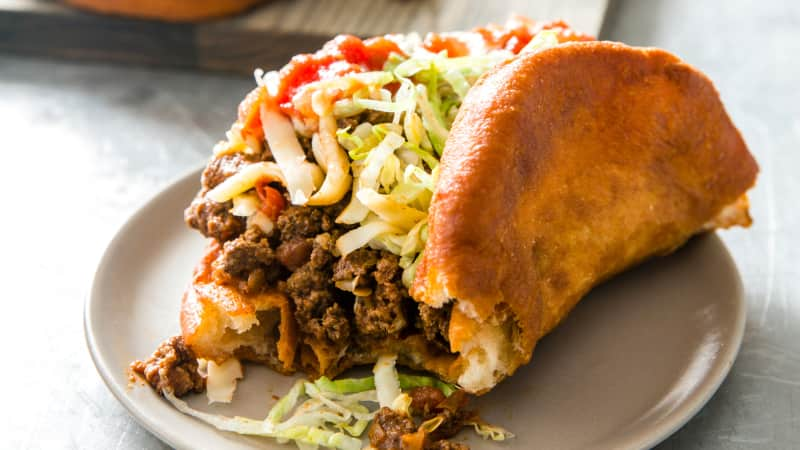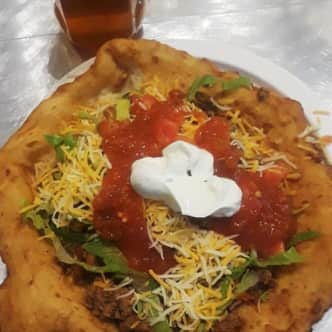Jan Iron has been making fry bread since she was 4 years old, but she still thinks of the simple dough—flour, baking powder, salt, water—as a work in progress. Some batches are just better than others.
Fry Bread: A Simple Recipe with a Complicated History
Published July 2, 2018.

Sign up for the Notes from the Test Kitchen newsletter
Our favorite tips and recipes, enjoyed by 2 million+ subscribers!
“We always say a prayer for it to be delicious and soft. You always try to put good thoughts into it because you’re feeding your family,” says Iron, who grew up in Shiprock, New Mexico, and is a member of the Navajo Nation. “My mom always said, ‘Don’t cook if you are angry or upset because it will get into the food and make everyone sick.’ So you have to change your attitude and be happy and loving as you make the fry bread.”
Emma and Beverly Morgan, known as the “fry bread queens” of Colorado, would agree. The sisters, fixtures at intertribal powwows since 2003, learned their skills as young girls growing up in Pinedale, New Mexico, on the Navajo Reservation.
In conversation, they complete each other’s sentences in Navajo and English. Emma narrates while Beverly scrolls through pictures on her phone: trays of puffy dough balls, breads lined up like Frisbees, crusts dipped into bowls of mutton stew, and tacos topped with ground beef, lettuce, tomato, and sour cream.
“People always say, ‘What is it about the way your fry bread tastes?’ It’s all right here,” Emma says, pointing to her forehead, “and right here,” pinching her fingers together. They use white Blue Bird Flour from Cortez, Colorado, salt, baking powder, and water. Never sugar. (Each tribe has its own fry bread style, and the Navajo prefer it savory.)
“We make the dough really soft, and then we get oil on our hands to make the dough balls. You stretch it, flap it back and forth—our hands know what to do,” she says, making a pattycake motion. “Then I put a little hole in the middle so it bubbles and cooks inside all the way around.”
In fact, the Navajo word for fry bread is dah díníilghaazh ("dock-de-kneel-a-gaj"). Dah means “edge”, and díníilghaazh is “bubbly.”
Ask just about anyone in Indian Country who makes the best fry bread, and they’ll say “my mom.” For the Morgans, it’s their grandmother, who still lives on the reservation near Gallup, New Mexico. “We go down and learn the old traditional food ways from her,” says Emma. “According to my grandma, fry bread’s been around since they did that long walk.”
Fry bread has become traditional, but we know it’s not ancient. Many people shared the experience of commodity foods, and now that’s part of the Native experience.
The Long Walk refers to the forced relocation of the Navajo people from their traditional home to Fort Sumner 300 miles to the east. Beginning in early 1864, nearly 10,000 people trudged across the desert, leaving behind cornfields, orchards, and flocks of sheep. Thousands died. After enduring three years of starvation and internment, the Navajo were allowed to return to their lands and given rations of unfamiliar commodities. Sugar replaced fruit syrup, maple sugar, and honey. Processed white flour replaced cornmeal. Packaged lard, and later, shortening, replaced animal fat.


“Fry bread is iconic, but it’s kind of a twisted thing,” says Jamie Folsom, a Colorado State University journalism instructor and member of the Choctaw Nation of Oklahoma, where the fry bread is smaller and sweeter than its Navajo cousin and often made with yeast.
“Fry bread has become traditional, but we know it’s not ancient. Many people shared the experience of commodity foods, and now that’s part of the Native experience. Fry bread—it’s so tasty, but it replaces a lot of things. It replaces a lifestyle where you work to get those things instead of receiving them.”
The indigenous food sovereignty movement tells American Indians to “decolonize your diet,” in the words of Devon Mihesuah of the American Indian Health and Diet Project.
Fry Bread Tacos
Load ’em up, fold ’em over, and enjoy these savory beef tacos.“It is not a trend,” says Folsom. “It is an effective, wonderful, mobilizing way to reclaim our sovereignty over our own bodies, our communities, our ways of being and relating with the world. It’s a powerful response to a public health crisis that has been hundreds of years in the making.”
But it’s hard to say no to deep-fried dough. “Even a medicine man, if you give him a loaf of white bread, he’s not going to eat it. He’s going to take the fry bread over that loaf,” says Emma Morgan.
And Jan Iron is going to keep working to perfect her recipe. “I know it’s a health issue, but you can’t control what everybody eats. On social media, people are saying this is killing us, or that it came from oppression. But we still enjoy it once in a while.”
Use our Fry Bread Tacos recipe to replicate this historic dish at home.
